The final brief of exploring the relationship between urbanization and visual pollution in Datong.
In my exploration of the subject of urbanization, I have found that visual pollution is a special kind of pollution that is different from other environmental pollution. And this problem is particularly serious in the process of urbanization. It has a wide scope, not only in relation to the environment, but also in relation to the people who live in cities. According to George Murray, it is very difficult to think in terms of visual pollution. It reminds me of how often in life we are drawn to things that not only divert attention, but also make things less attractive that should be visually pleasing. Visual pollution is an aesthetic problem that refers to the way in which pollution affects one’s ability to appreciate a vista or view. The term is widely used to cover limitations invisibility, the ability to see distant objects, as well as more subjective issues of visual clutter, intrusion into the fabric of other ‘pretty’ scenes, and graffiti and other visual defacement. Visual pollution takes many forms, most of which are caused by human behavior. And it can have a significant negative impact on people’s well-being and health.
Mrs Bird Johnson once said in response to the proliferation of billboards that ugliness is so grim. There are many different causes of visual pollution, including advertising. They are basically summarized in 15 categories: landfill, litter, smoke, plastic pollution, buildings, power lines, antennas, vandalism, traffic signs, light pollution, air travel, excessive waste generation, over-consumption, natural causes, etc. As for the effects of visual pollution, they include the effects on people, the effects on cities and the effects on the environment. There are basically ten main categories: low quality of life for humans, psychological and physical health problems, eye strain, distractions, accidents, falling property prices, loss of the original character of the area, neglect of areas with high levels of visual pollution, and effects on the surrounding flora and fauna. Because there are so many causes and effects, I can use a variety of forms to express these. And they can be collected in a rich variety of materials to explore and design for the following. So these causes and influences are what I need to focus on in this project. The ultimate aim of the project is to make people aware of visual pollution in various ways and to understand that much of it is caused by human behavior. Through my project, I aim to create awareness of the need to reduce visual pollution. The aim is to reduce or solve visual pollution.
Regarding the methodology, first I needed to collect the materials mentioned earlier. Have they analyzed and organized. Then I would like to use questionnaires or interviews etc. To investigate people’s perceptions and tolerance levels of these different types and effects of visual pollution. The resulting results are then presented in the form of data. This way the results of the research can be visualized. This data is then used to create visual designs. For example posters and videos. This allows people to see the impact of visual pollution in a realistic way. Draw attention to it. As the scope of visual pollution is large. So I decided to be specific to specific visual pollution in specific locations. That is, the visual pollution of the city council at different times in Datong and Datong. Different posters could be created based on the different findings. Posters are a very common visual design, product and can be placed in many places and can easily interact with anyone. The second step can be to create a relevant video based on the findings of the study. This can be uploaded to the Artivive website to create a link to the posters. People can scan the static poster to see the video in motion. This creates a more interesting interactive AR effect. Use a variety of ways to draw attention to visual pollution.
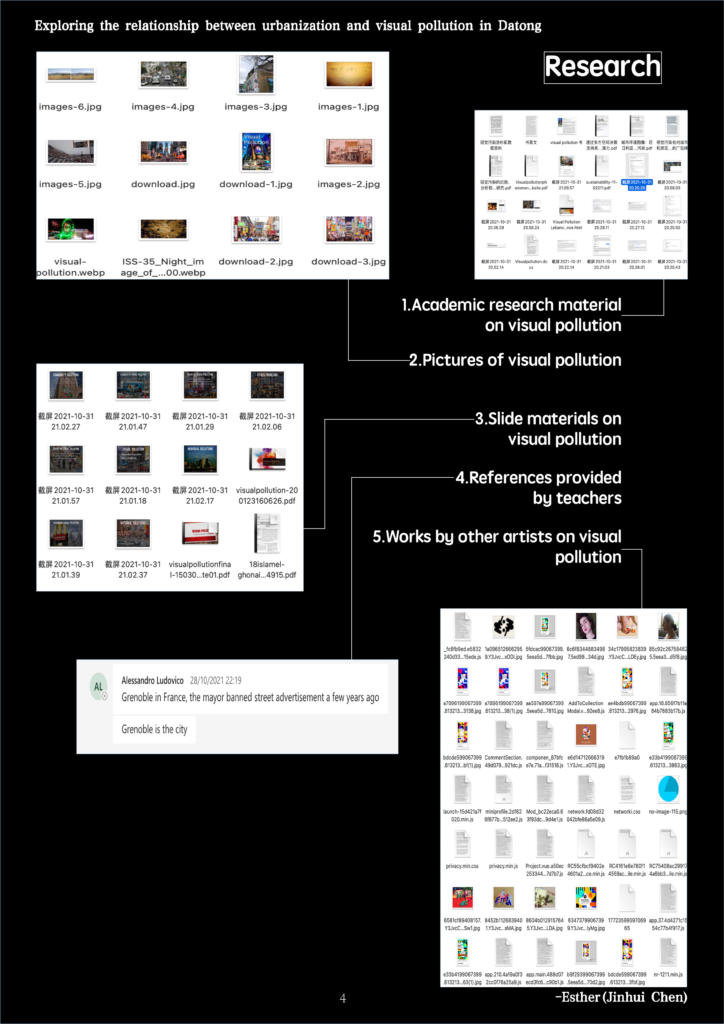
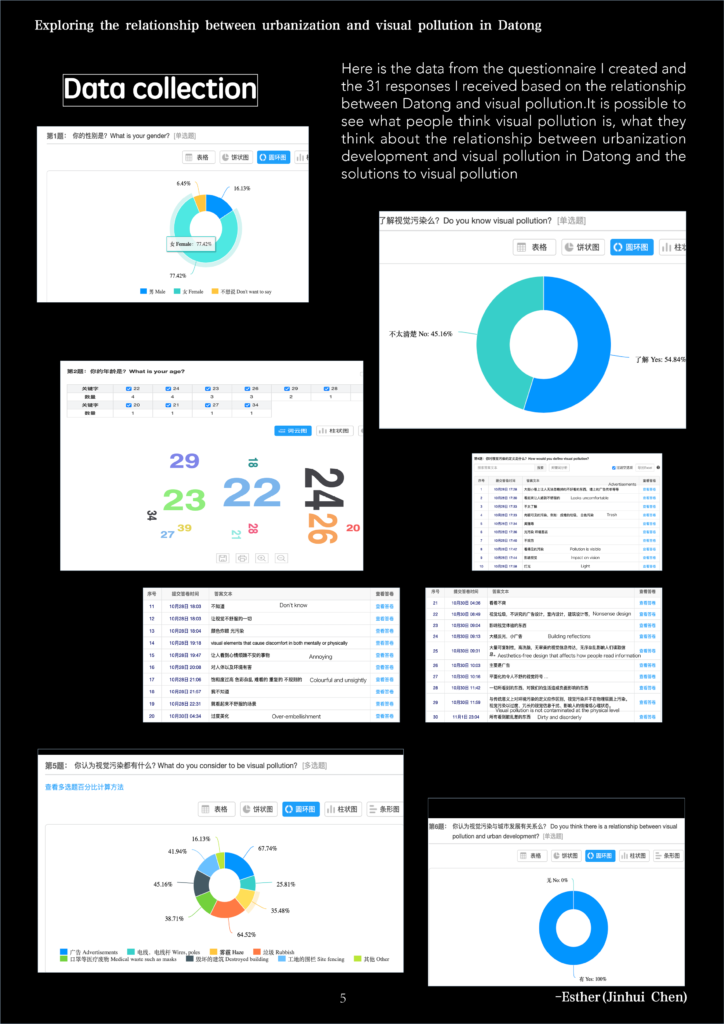
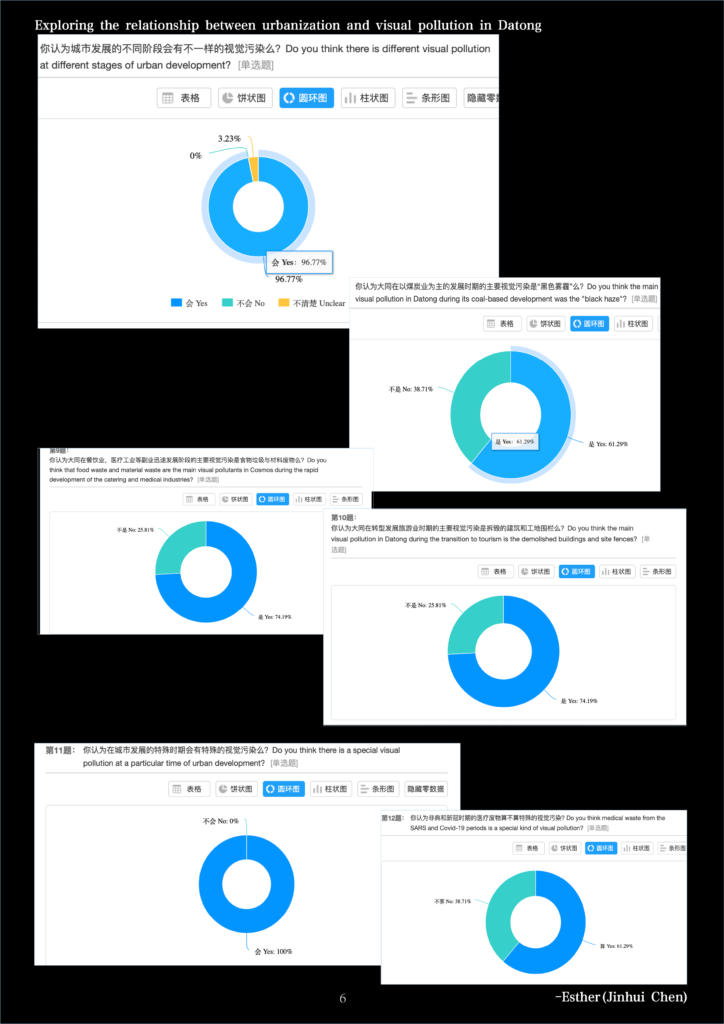
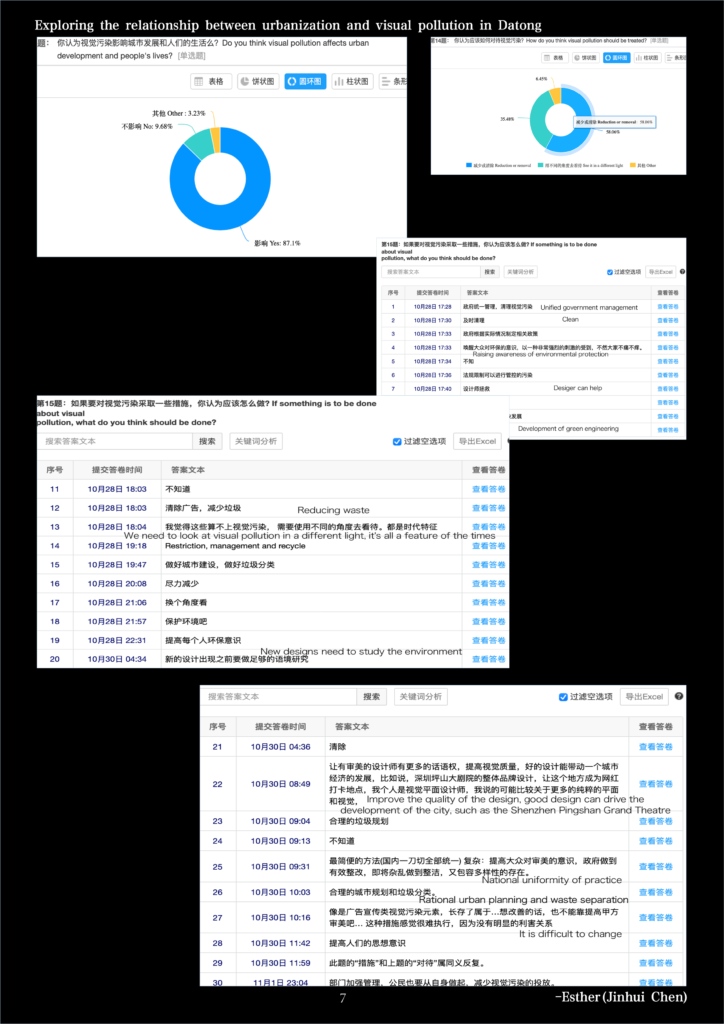
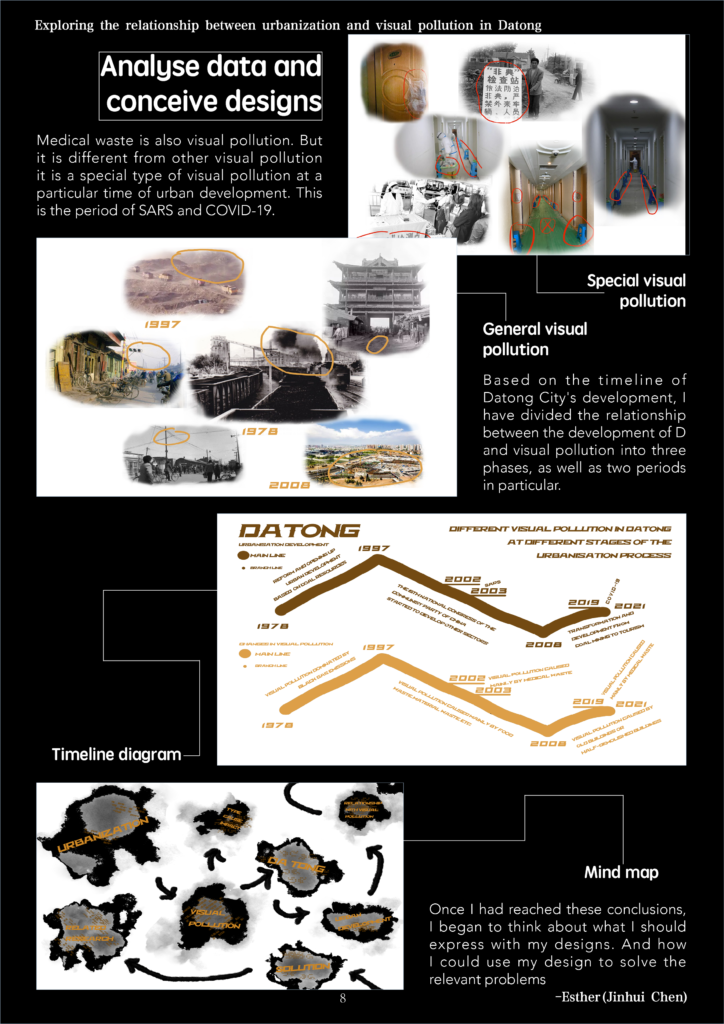
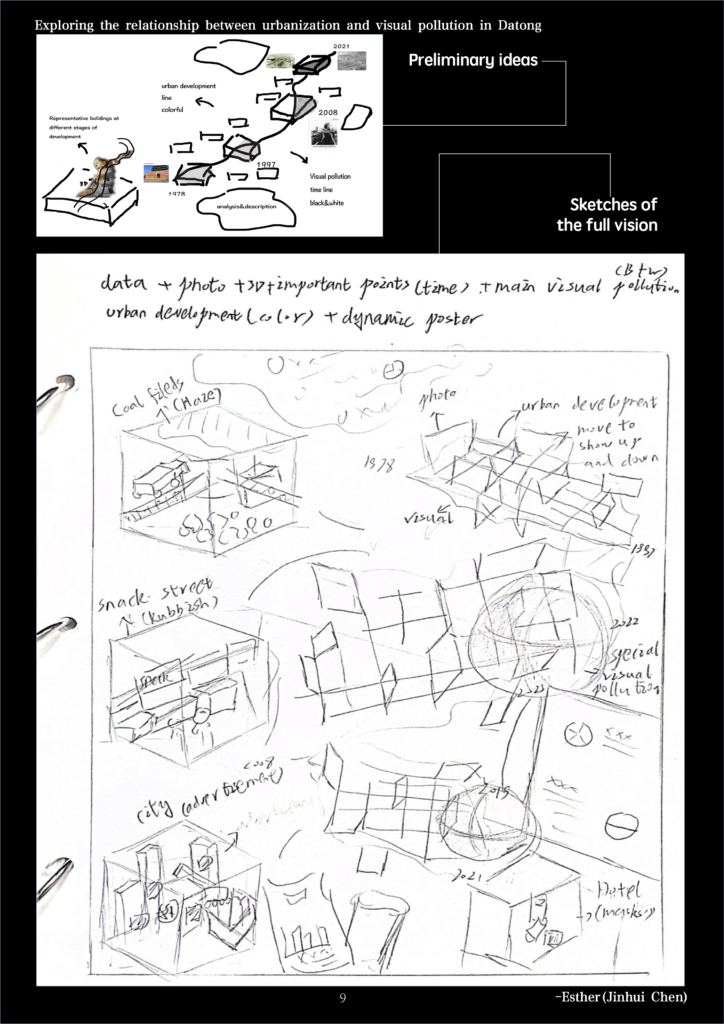
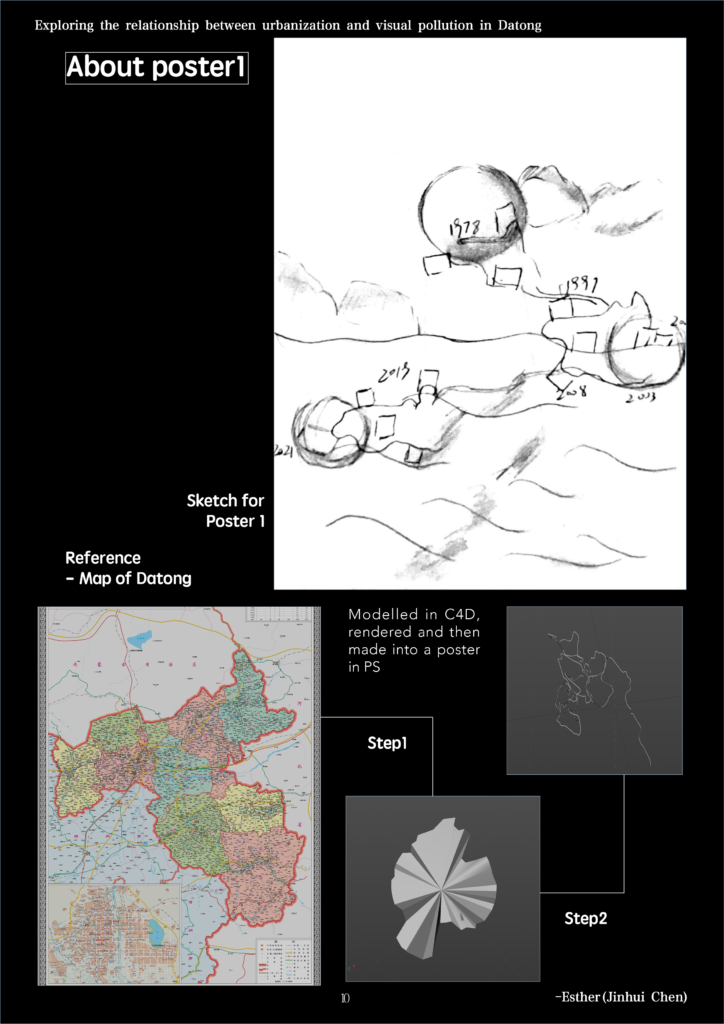
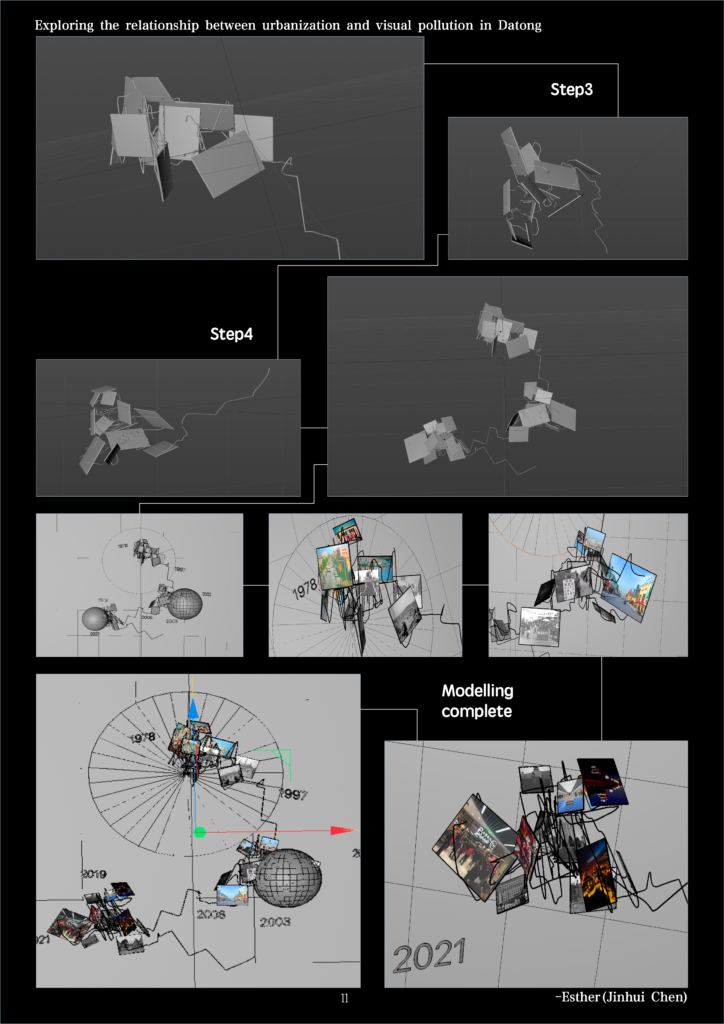
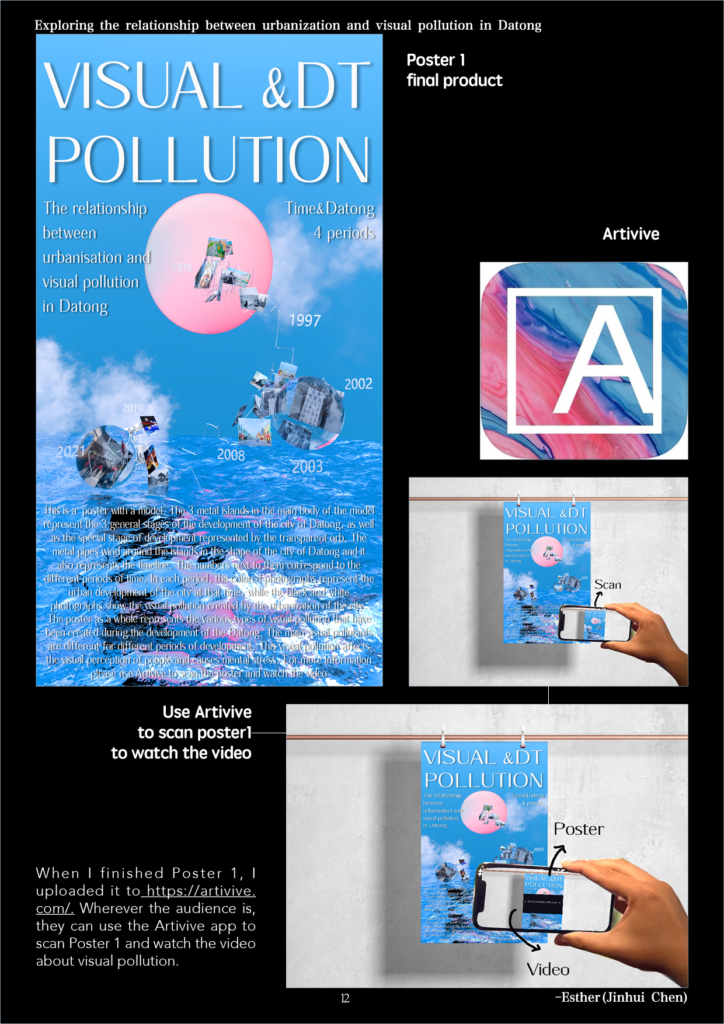
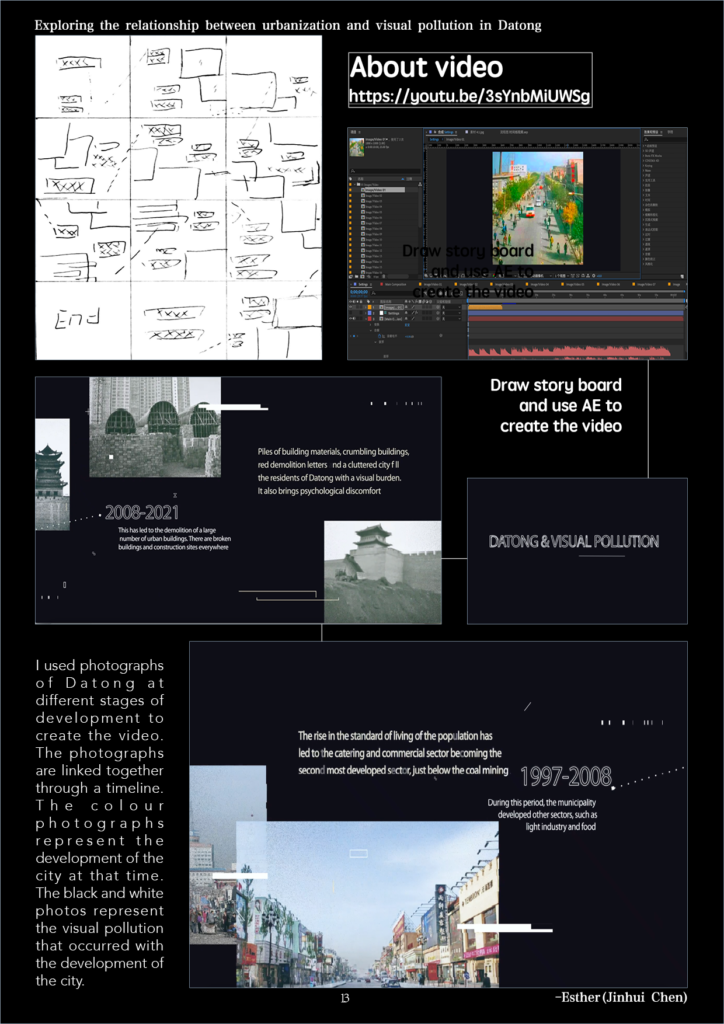
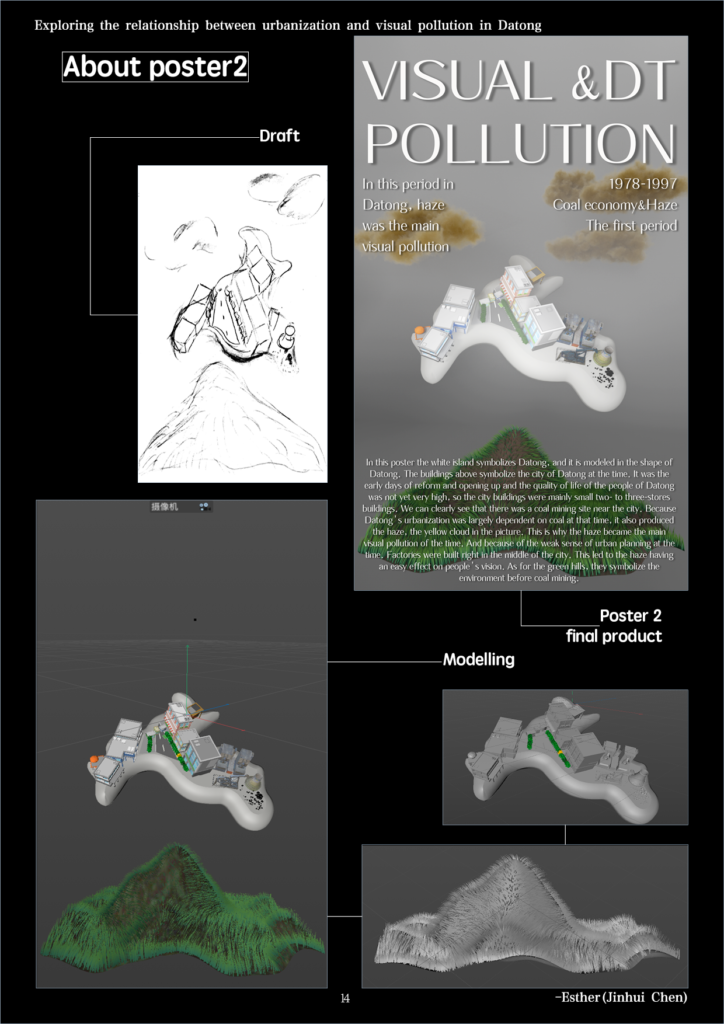

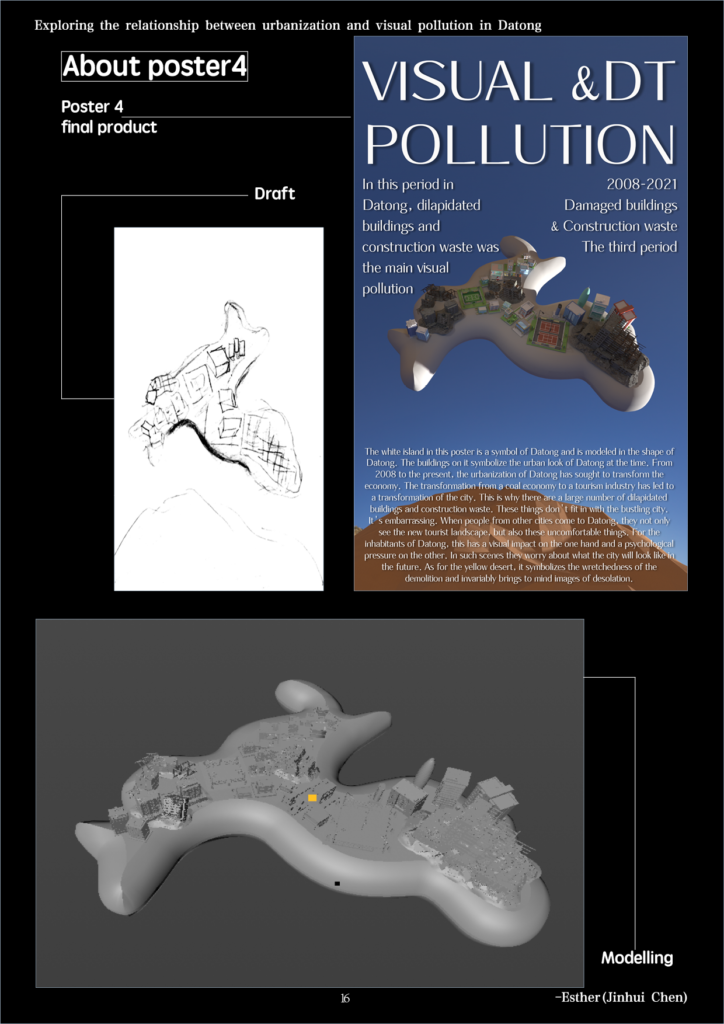
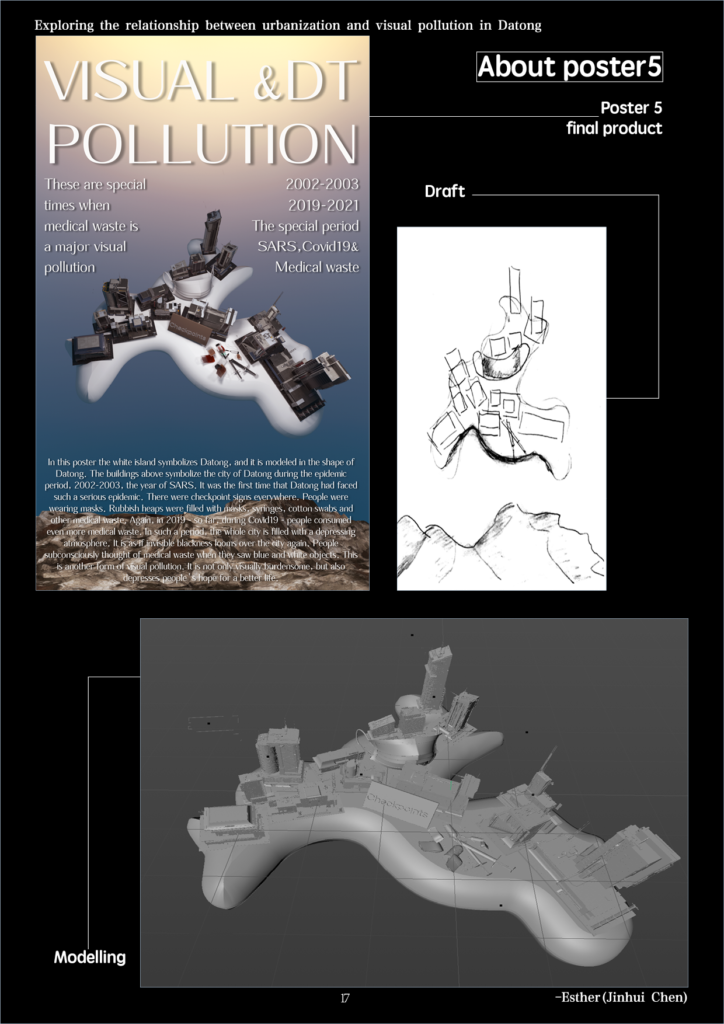
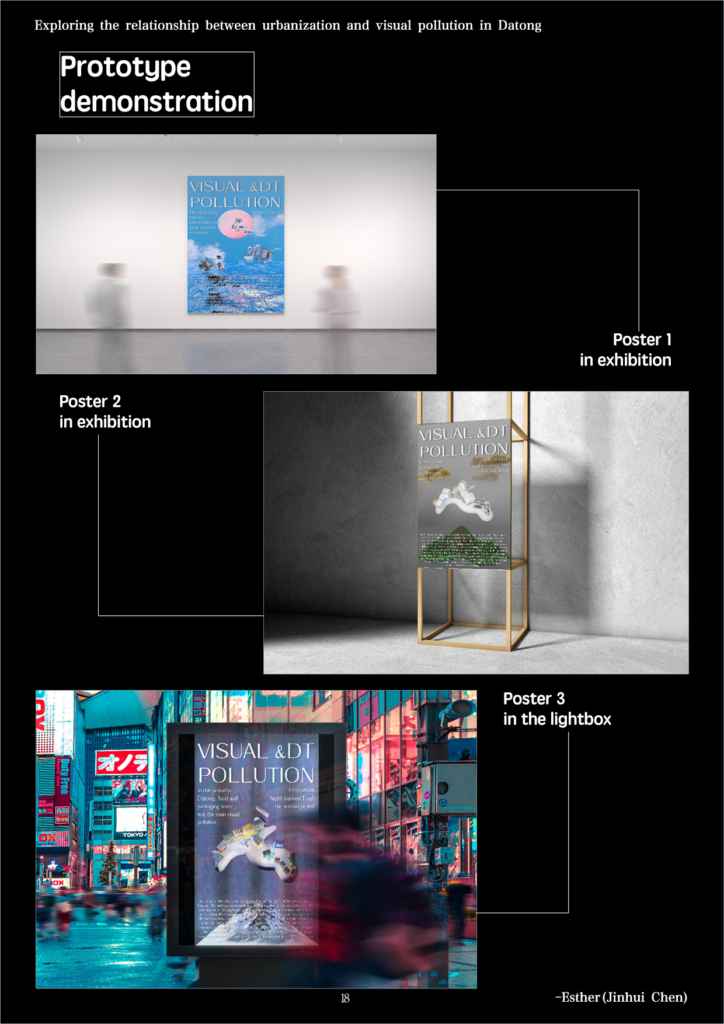

Reflections on the project to explore the relationship between urbanization and visual pollution in Datong
Firstly, I collected a lot of material on the urbanization of the city of Datong. After analyzing and organizing them. I found out that the different stages of urbanization have different visual pollution. The main visual pollution changes with the direction of urban development, so I wanted to create a questionnaire and interview people to find out how they perceive and tolerate the different types and effects of visual pollution. I also investigated their perceptions of the relationship between the development of Datong City and the different types of visual pollution. The results were then presented in the form of data. So that the results of the research can be visualized. Based on the information and data I then analyzed that Datong City can be divided into 3 main stages of development since the reform and opening up to the present. The figures are 1978-1997, 1997-2008 and 2008-2021. The period 1978-1997 was the first phase of development for the city of Datong, from the reform and opening up to the start of the restaurant industry. The second phase of Datong’s development, from 1997 to 2008, was the period during which the food service industry flourished.During that time, coal mining was progressively formalized and some environmental concerns were addressed and improved. The mist has cleared up. It was at this point that the municipality of Datong began to support the development of other industries. The rise in the standard of living of the population led to a boom in the restaurant industry during that period. Overnight markets have been created. The third stage of urbanization, from 2008 to 2021, saw a change in the direction of economic development in Datong.Transforming an energy economy into a tourist economy. As a consequence, a mass urban transformation took place. This led to the emergence of a large number of dilapidated buildings and construction waste. Along with these three phases, the 2002-2003 SARS period and the 2019-2021 COVID-19 period are included in my research. These two are part of special times in the urban development of the town of Datong.Because of the outbreak, urban development was limited, but medical waste such as masks did not increase. In contrast to other visual pollution, this is a visual pollution, which can only be found at special times. Based on that, I created the visual design. Posters and videos were created. So that people can see the effects of vision pollution realistically. I hope this will bring attention to the significance of pollution in the city. I also hope that people will understand that visual pollution is an integral part of urbanization. Posters are a very common visual design, produced and may be placed in many places for that reason. And I uploaded the video to the Artivive website to create a link with the posters. People can see the moving video by scanning the first poster.
In exploring the subject of urbanization, I discovered that visual pollution is a specific type of pollution that differs from other environmental pollutants. And this problem is especially severe in the process of urbanization. It is broad, not only in terms of the environment, but also in terms of the people who live in the cities. George Murray once said that visual pollution is a very difficult thing to think about. It reminds me how often in life we are attracted to things that not only distract attention, but also make things less attractive that should be visually pleasurable.Visual pollution is an aesthetic problem that refers to the way in which pollution affects one’s ability to appreciate a vista or view. The term is widely used to cover limitations invisibility, the ability to view distant objects, as well as more subjective problems of visual clutter, intrusion into the fabric of other ‘pretty’ scenes, and graffiti and other visual defacement. Mrs Byrd Johnson once said about the proliferation of billboards: ugliness is so grim. (2001) Yet when it comes to graffiti and advertising, I think of minimalism and maximalism. Are specific visual pollutions such as graffiti and advertisements considered minimalist? And is it a primitive scene with this removed minimalism? For those who like minimalism might be a form of visual pollution. So is visual pollution an alternative aesthetic from other perspectives? The Canadian photographer Kyle Berger has used digital editing to poetically express various kinds of visual pollution as works of art. The graffiti in São Paulo, Brazil, has also become a calling card for that cosmopolitan city because of its unique style. Therefore, through my project, I hope to make people aware of visual pollution. To understand that a lot of visual pollution is caused by human behavior. On the one hand, I hope that through my project I can make people aware of the need to reduce visual pollution. This will lead to a reduction in visual pollution. On the other hand, I hope that people will think about the possibility of transforming some visual pollution from pollution to beauty.
Through this project, it became clear to me that there are many dangers associated with a lack of visual pollution. Not only on a mental level but also a physical level. According to Jana, M, and De, T. visual pollution can lead to a decline in people’s aesthetic sensibilities and can also lead to diseases such as asthma (2015). In addition to this, it is also clear that visual pollution is an aesthetic problem that accompanies urban development. That is, what detracts from urban planning and a good image is referred to as visual pollution. (Bankole, O, 2013). After studying the nature of visual pollution. It is the ultimate aim of this project to explore ways of dealing with visual pollution. In this project, although I have narrowed down the scope of visual pollution to a few specific types in a fixed city. However, the final message of the project is still not clear. There is no scientific approach to data analysis. The project itself focused more on the visual pollution of Datong, but not on the solutions to the visual pollution. The final presentation of the project was also not appropriate. All of these things will affect the impact of the project. However, the project was still very valuable. Through this project, I have gained experience in conducting academic research from start to finish as a person. I was able to develop my skills. I also understood the importance of time planning. The overall control of a project is a very difficult thing to do. What you want to achieve in this project is very different from what you planned. It is important to think about the project from the beginning and to find the best way to present it. It is also important not to limit yourself to fads and techniques. It is important to keep in mind the purpose of the project and not just to present a cool image. Overall the project has many shortcomings, but it does examine the relationship between visual pollution and urban development. It is also representative of the specific visual pollution of a particular city. In terms of visual presentation, a combination of 2D and 3D was chosen to make the visual presentation richer. And the Artivive website was used to quickly implement the AR interactive effect, saving time finished and manpower. Making good use of the available tools is the right approach for the project research.
This final project brings my postgraduate life to a successful conclusion. It is a summary of what I have learned during my postgraduate studies. Data visualization, the expression of self-awareness, different forms of presentation, observing the work of others. All these important course elements were used in my final project. During this year of study, I have opened my mind and learned to research according to the different cultures of different countries. Finding the central purpose of different topics. I have also learned many new techniques that I can use in my future work such as data visualization, C4D, and AE. These will make me more competitive in the market for jobs. Not only graphic design but also design industries such as film and post-production and interactive art. Trying to combine different design approaches and techniques can produce new and innovative artwork. Not being limited to a single traditional design is the direction I want to take in the future. The most useful thing I have learned from this project is the importance of ideas. Good design is generated by a wealth of ideas. Staying creative is something I need in my studies as well as in my career. Also, a wealth of knowledge and theory is fundamental to everything. The method is important in everything you do. This has helped me to understand the importance of knowing the client well in my future career. I encountered a lot of difficulties while working on this project. Lack of understanding of new technologies, poor time planning, laziness, etc. The fact that plans can never catch up with change and not underestimate my laziness are two things that will always remind me in the future. In addition, to become a good designer, I need to accumulate quantity. In general, I should persistently read and practice more. Look at a lot of artworks to improve aesthetics, do a lot of practice to improve experience and skills. The most important thing is that persistence is the only way to achieve your dream.
Jinhui Chen(Esther)
1588words
References
Andreas, 2021. 36 Causes, Effects & Solutions For Visual Pollution – E&C. [online] E&C. Available at: <https://environmental-conscience.com/visual-pollution-causes-effects-solutions/> [Accessed 12 December 2021].
Bankole, O., 2013. URBAN ENVIRONMENTAL GRAPHICS : IMPACT , PROBLEMS AND VISUAL POLLUTION OF SIGNS AND BILLBOARDS IN NIGERIAN CITIES. [online] Semantic Scholar. Available at: <https://www.semanticscholar.org/paper/URBAN-ENVIRONMENTAL-GRAPHICS-%3A-IMPACT-%2C-PROBLEMS-OF-Bankole/a28843a5e71aeb2c7bf79fdcbc22bab9bef8a06d> [Accessed 12 December 2021].
Jana, M. and Tanaya, T., 2015. VISUAL POLLUTION CAN HAVE A DEEP DEGRADING EFFECT ON URBAN AND SUBURBAN COMMUNITY: A STUDY IN FEW PLACES OF BENGAL, INDIA, WITH SPECIAL REFERENCE TO UNORGANIZED BILLBOARDS. [online] semantic scholar. Available at: <https://www.semanticscholar.org/paper/VISUAL-POLLUTION-CAN-HAVE-A-DEEP-DEGRADING-EFFECT-A-Jana-De/435e91c4f03224a93a91dbc37c33e368db8f59ca> [Accessed 12 December 2021].
Lopvet, R., 2018. Kyle Berger : Near-dead capitalism – Der Greif. [online] Der Greif. Available at: <https://dergreif-online.de/artist-blog/kyle-berger-near-dead-capitalism/> [Accessed 12 December 2021].
Marshall, E., 2017. [online] Available at: <https://theculturetrip.com/south-america/brazil/articles/10-reasons-why-you-should-visit-sao-paulo-over-rio-de-janeiro/> [Accessed 12 December 2021].
Production, M. and Austin, K., 2001. Lady Bird Johnson: The First Lady’s Beautification Campaign. [online] Pbs.org. Available at: <https://www.pbs.org/ladybird/shattereddreams/shattereddreams_report.html> [Accessed 12 December 2021].
